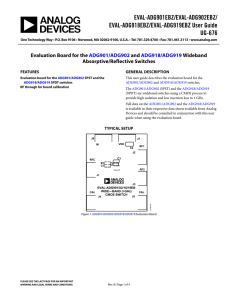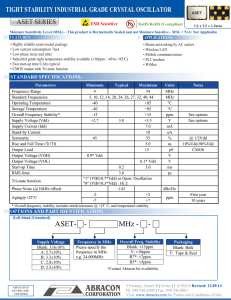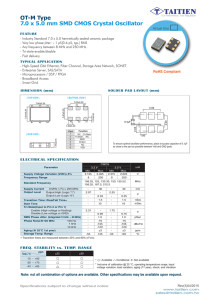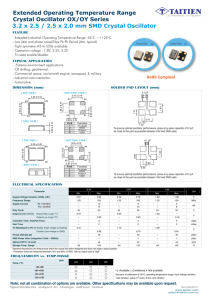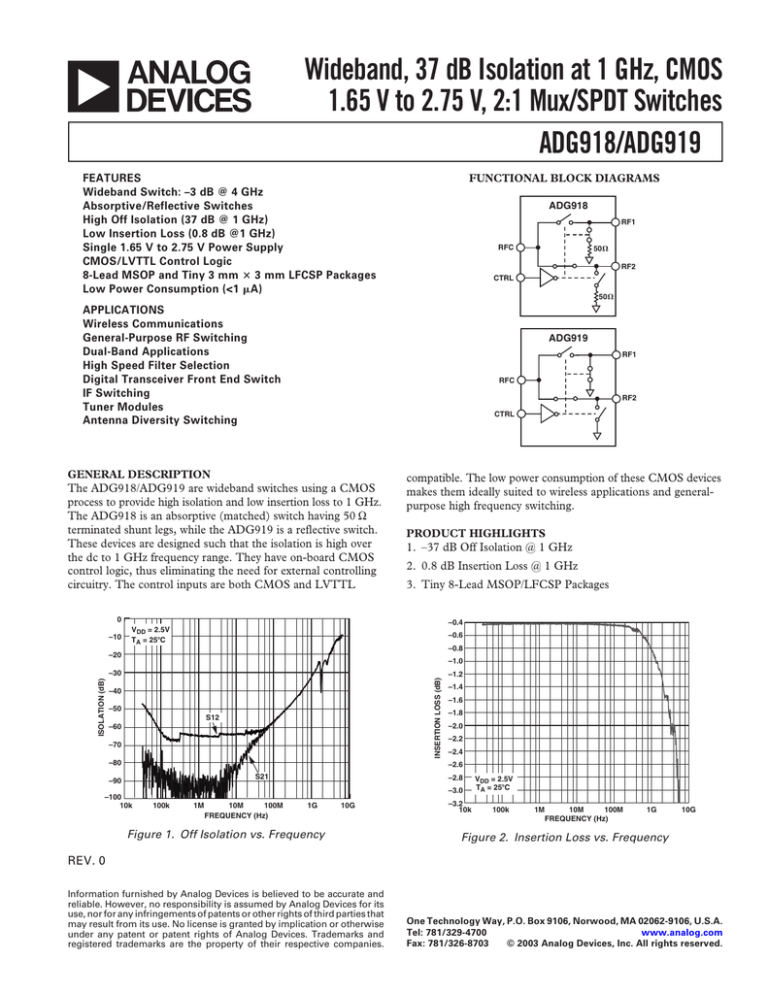
Wideband, 37 dB Isolation at 1 GHz, CMOS
1.65 V to 2.75 V, 2:1 Mux/SPDT Switches
ADG918/ADG919
FEATURES
Wideband Switch: –3 dB @ 4 GHz
Absorptive/Reflective Switches
High Off Isolation (37 dB @ 1 GHz)
Low Insertion Loss (0.8 dB @1 GHz)
Single 1.65 V to 2.75 V Power Supply
CMOS/LVTTL Control Logic
8-Lead MSOP and Tiny 3 mm 3 mm LFCSP Packages
Low Power Consumption (<1 A)
FUNCTIONAL BLOCK DIAGRAMS
ADG918
RF1
RFC
RF2
CTRL
50
APPLICATIONS
Wireless Communications
General-Purpose RF Switching
Dual-Band Applications
High Speed Filter Selection
Digital Transceiver Front End Switch
IF Switching
Tuner Modules
Antenna Diversity Switching
ADG919
RF1
RFC
RF2
CTRL
GENERAL DESCRIPTION
The ADG918/ADG919 are wideband switches using a CMOS
process to provide high isolation and low insertion loss to 1 GHz.
The ADG918 is an absorptive (matched) switch having 50 Ω
terminated shunt legs, while the ADG919 is a reflective switch.
These devices are designed such that the isolation is high over
the dc to 1 GHz frequency range. They have on-board CMOS
control logic, thus eliminating the need for external controlling
circuitry. The control inputs are both CMOS and LVTTL
compatible. The low power consumption of these CMOS devices
makes them ideally suited to wireless applications and generalpurpose high frequency switching.
PRODUCT HIGHLIGHTS
1. –37 dB Off Isolation @ 1 GHz
2. 0.8 dB Insertion Loss @ 1 GHz
3. Tiny 8-Lead MSOP/LFCSP Packages
0
–10
–0.4
VDD = 2.5V
TA = 25C
–0.6
–0.8
–20
–1.0
INSERTION LOSS (dB)
–30
ISOLATION (dB)
50
–40
–50
S12
–60
–70
–80
–1.2
–1.4
–1.6
–1.8
–2.0
–2.2
–2.4
–2.6
S21
–90
–100
10k
–2.8
–3.0
100k
1M
10M
100M
FREQUENCY (Hz)
1G
10G
–3.2
10k
VDD = 2.5V
TA = 25C
100k
1M
10M
100M
FREQUENCY (Hz)
1G
10G
Figure 1. Off Isolation vs. Frequency
Figure 2. Insertion Loss vs. Frequency
Information furnished by Analog Devices is believed to be accurate and
reliable. However, no responsibility is assumed by Analog Devices for its
use, nor for any infringements of patents or other rights of third parties that
may result from its use. No license is granted by implication or otherwise
under any patent or patent rights of Analog Devices. Trademarks and
registered trademarks are the property of their respective companies.
One Technology Way, P.O. Box 9106, Norwood, MA 02062-9106, U.S.A.
Tel: 781/329-4700
www.analog.com
Fax: 781/326-8703
© 2003 Analog Devices, Inc. All rights reserved.
REV. 0
= 1.65 V to 2.75 V, GND = 0 V, input power = 0 dBm,
T to T , unless otherwise noted.)
ADG918/ADG919–SPECIFICATIONS1 (Vall specifications
DD
MIN
Parameter
Symbol
AC ELECTRICAL CHARACTERISTICS
Operating Frequency3
–3 dB Frequency4
Input Power4
Conditions
MAX
Min
B Version
Typ2
Max
DC
Insertion Loss
S21, S12
Isolation—RFC to RF1/RF2
S21, S12
Isolation—RF1 to RF2
(Crosstalk)
S21, S12
Return Loss (On Channel)4
S11, S22
Return Loss (Off Channel)4
ADG918
S11, S22
On Switching Time4
Off Switching Time4
Rise Time4
Fall Time4
1 dB Compression4
Third Order Intermodulation Intercept
Video Feedthrough5
tON
tOFF
tRISE
tFALL
P–1 dB
IP3
0 V dc Bias
0.5 V dc Bias
DC to 100 MHz; VDD = 2.5 V ± 10%
500 MHz; VDD = 2.5 V ± 10%
1000 MHz; VDD = 2.5 V ± 10%
100 MHz
55
500 MHz
43
1000 MHz
34
100 MHz
54
500 MHz
39
1000 MHz
31
DC to 100 MHz
21
500 MHz
22
1000 MHz
22
DC to 100 MHz
18
500 MHz
17
1000 MHz
16
50% CTRL to 90% RF
50% CTRL to 10% RF
10% to 90% RF
90% to 10% RF
1000 MHz
900 MHz/901 MHz, 4 dBm
30
DC ELECTRICAL CHARACTERISTICS
Input High Voltage
VINH
VINH
Input Low Voltage
VINL
VINL
Input Leakage Current
II
VDD = 2.25 V to 2.75 V
VDD = 1.65 V to 1.95 V
VDD = 2.25 V to 2.75 V
VDD = 1.65 V to 1.95 V
0 ≤ VIN ≤ 2.75 V
CAPACITANCE4
RF1/RF2, RF Port On Capacitance
CTRL Input Capacitance
CRF ON
CCTRL
f = 1 MHz
f = 1 MHz
POWER REQUIREMENTS
VDD
Quiescent Power Supply Current
IDD
Digital inputs = 0 V or VDD
0.4
0.5
0.8
60
47
37
57
42
33
27
27
26
23
21
20
6.6
6.5
6.1
6.1
17
36
2.5
2
4
7
16
0.7
0.8
1.25
10
9.5
9
9
1.7
0.65 VCC
± 0.1
0.7
0.35 VCC
±1
1.6
2
1.65
0.1
Unit
GHz
GHz
dBm
dBm
dB
dB
dB
dB
dB
dB
dB
dB
dB
dB
dB
dB
dB
dB
dB
ns
ns
ns
ns
dBm
dBm
mV p-p
V
V
V
V
µA
pF
pF
2.75
1
V
µA
NOTES
1
Temperature range B Version: –40°C to +85°C.
2
Typical values are at V DD = 2.5 V and 25°C, unless otherwise stated.
3
Point at which insertion loss degrades by 1 dB.
4
Guaranteed by design, not subject to production test.
5
The dc transience at the output of any port of the switch when the control voltage is switched from high to low or low to high in a 50 Ω test setup, measured with 1 ns
rise time pulses and 500 MHz bandwidth.
Specifications subject to change without notice.
–2–
REV. 0
ADG918/ADG919
ABSOLUTE MAXIMUM RATINGS 1
LFCSP Package
JA Thermal Impedance (2-layer board) . . . . . . . . . . 84°C/W
JA Thermal Impedance (4-layer board) . . . . . . . . . . 48°C/W
Lead Temperature, Soldering (10 sec) . . . . . . . . . . . . . 300°C
IR Reflow, Peak Temperature (<20 sec) . . . . . . . . . . . . 235°C
ESD . . . . . . . . . . . . . . . . . . . . . . . . . . . . . . . . . . . . . . . . . . 1 kV
(TA = 25°C, unless otherwise noted.)
VDD to GND . . . . . . . . . . . . . . . . . . . . . . . . . . –0.5 V to +4 V
Inputs to GND . . . . . . . . . . . . . . . . . . –0.5 V to VDD + 0.3 V2
Continuous Current . . . . . . . . . . . . . . . . . . . . . . . . . . . 30 mA
Input Power . . . . . . . . . . . . . . . . . . . . . . . . . . . . . . . . . 18 dBm
Operating Temperature Range
Industrial (B Version) . . . . . . . . . . . . . . . . –40°C to +85°C
Storage Temperature Range . . . . . . . . . . . . –65°C to +150°C
Junction Temperature . . . . . . . . . . . . . . . . . . . . . . . . . . 150°C
MSOP Package
JA Thermal Impedance . . . . . . . . . . . . . . . . . . . . . 206°C/W
NOTES
1
Stresses above those listed under Absolute Maximum Ratings may cause permanent damage to the device. This is a stress rating only and functional operation of
the device at these or any other conditions above those listed in the operational
sections of this specification is not implied. Exposure to absolute maximum rating
conditions for extended periods may affect device reliability. Only one absolute
maximum rating may be applied at any one time.
2
RF1/RF2 Off Port Inputs to Ground .............................. –0.5 V to VDD – 0.5 V
ORDERING GUIDE
Model
Temperature Range
Package Description
Package Option
Branding
ADG918BRM
ADG918BRM-REEL7
ADG918BCP
ADG918BCP-REEL7
ADG919BRM
ADG919BRM-REEL7
ADG919BCP
ADG919BCP-REEL7
–40°C to +85°C
–40°C to +85°C
–40°C to +85°C
–40°C to +85°C
–40°C to +85°C
–40°C to +85°C
–40°C to +85°C
–40°C to +85°C
Mini Small Outline Package (MSOP)
Mini Small Outline Package (MSOP)
Lead Frame Chip Scale Package (LFCSP)
Lead Frame Chip Scale Package (LFCSP)
Mini Small Outline Package (MSOP)
Mini Small Outline Package (MSOP)
Lead Frame Chip Scale Package (LFCSP)
Lead Frame Chip Scale Package (LFCSP)
RM-8
RM-8
CP-8*
CP-8*
RM-8
RM-8
CP-8*
CP-8*
W4B
W4B
W4B
W4B
W5B
W5B
W5B
W5B
*Contact factory for availability.
CAUTION
ESD (electrostatic discharge) sensitive device. Electrostatic charges as high as 4000 V readily
accumulate on the human body and test equipment and can discharge without detection. Although the
ADG918/ADG919 features proprietary ESD protection circuitry, permanent damage may occur on
devices subjected to high energy electrostatic discharges. Therefore, proper ESD precautions are
recommended to avoid performance degradation or loss of functionality.
PIN CONFIGURATION
8-Lead MSOP (RM-8)
8-Lead 3 mm 3 mm LFCSP (CP-8)
ADG918/
ADG919
Mnemonic
Function
1
VDD
2
CTRL
3, 6, 7
GND
4
5
8
RFC
RF2
RF1
Power Supply Input. These parts can
be operated from 1.65 V to 2.75 V,
and VDD should be decoupled to GND.
CMOS or TTL Logic Level;
0 ➞ RF2 to RFC
1 ➞ RF1 to RFC
Ground Reference Point for All
Circuitry on the Part
COMMON RF Port for Switch
RF2 Port
RF1 Port
7 GND
6 GND
TOP VIEW
RFC 4 (Not to Scale) 5 RF2
GND 3
Table I. Truth Table
REV. 0
Pin No.
8 RF1
VDD 1
CTRL 2
PIN FUNCTION DESCRIPTIONS
CTRL
Signal Path
0
1
RF2 to RFC
RF1 to RFC
–3–
ADG918/ADG919
TERMINOLOGY
Parameter
Description
VDD
IDD
GND
CTRL
VINL
VINH
IINL (IINH)
CIN
tON
tOFF
tRISE
tFALL
Off Isolation
Most positive power supply potential
Positive supply current
Ground (0 V) reference
Logic control input
Maximum input voltage for Logic 0
Minimum input voltage for Logic 1
Input current of the digital input
Digital input capacitance
Delay between applying the digital control input and the output switching on.
Delay between applying the digital control input and the output switching off.
Rise time. Time for the RF signal to rise from 10% to 90% of the ON level.
Fall time. Time for the RF signal to fall from 90% to 10% of the ON level.
The attenuation between input and output ports of the switch when the switch control voltage is in the
OFF condition.
Insertion Loss
The attenuation between input and output ports of the switch when the switch control voltage is in the
ON condition.
1 dB compression point. The RF input power level at which the switch insertion loss increases by 1 dB over its
P–1 dB
low level value. It is a measure of how much power the ON switch can handle before the insertion loss increases
by 1 dB.
Third order intermodulation intercept. This is a measure of the power in false tones that occur when closely spaced
IP3
tones are passed through a switch, whereby the nonlinearity of the switch causes these false tones to be generated.
Return Loss
The amount of reflected power relative to the incident power at a port. Large return loss indicates good matching.
By measuring Return Loss the VSWR can be calculated from conversion charts. VSWR (voltage standing wave ratio)
indicates degree of matching present at a switch RF port.
Video Feedthrough Spurious signals present at the RF ports of the switch when the control voltage is switched from high to low
or low to high without an RF signal present.
–4–
REV. 0
Typical Performance Characteristics–ADG918/ADG919
–0.40
VDD = 2.5V
–0.45
VDD = 2.75V
–0.50
VDD = 2.25V
–0.55
–0.60
–0.65
–0.70
–0.75
TA = 25C
100k
1M
10M 100M
FREQUENCY (Hz)
1G
10G
100k
1M
10M
100M
FREQUENCY (Hz)
1G
10G
TPC 2. Insertion Loss vs. Frequency
over Supplies (RF1/RF2, S12, and
S21) (Zoomed TPC 1 Plot)
0
V = 1.65V TO 2.75V
–10 T DD= 25C
A
–20
0
–40C
–10
VDD = 1.65V TO 2.75V
TA = 25C
–20
–30
–30
–40
S12
–50
–60
1G
10G
100k
1M
10M
100M
FREQUENCY (Hz)
1G
10G
TPC 5. Isolation vs. Frequency
over Supplies (RF1/RF2, ADG918)
S12 (+85C)
S12 (+25C)
–70
S12 (–40C)
S21
(–40C, +25C, +85C)
100k
1M
10M
100M
FREQUENCY (Hz)
1G
10G
TPC 7. Isolation vs. Frequency over
Temperature (RF1/RF2, ADG919)
REV. 0
–15
OFF SWITCH (ADG918)
X–TALK (dB)
RETURN LOSS (dB)
–10
–40
–20
–25
–30
ON SWITCH
–35
–40
10k
100k
1M
10M
100M
FREQUENCY (Hz)
1G
10G
TPC 8. Return Loss vs. Frequency
(RF1/RF2, S11)
–5–
S21
100k
1M
10M
100M
FREQUENCY (Hz)
1G
10G
TPC 6. Isolation vs. Frequency
over Supplies (RF1/RF2, ADG919)
TA = 25C
–5 VDD = 2.5V
–30
–90
–70
–100
10k
0
–100
10k
S12
–60
–90
S21
–90
10k
VDD = 2.5V
–80
–50
–80
–80
–10
–60
–40
–70
TPC 4. Insertion Loss vs. Frequency
over Temperature (RF1/RF2, S12,
and S21)
–50
10G
TPC 3. Insertion Loss vs. Frequency
over Supplies (RF1/RF2, S12, and S21)
ISOLATION (dB)
10k
TA = 25C
–0.80
10k
ISOLATION (dB)
INSERTION LOSS (dB)
VDD = 2.75V
INSERTION LOSS (dB)
VDD = 2.25V
–0.2
–0.4
–0.6
–0.8 +25C
+85C
–1.0
–1.2
–1.4
–1.6
–1.8
–2.0
–2.2
–2.4
–2.6
–2.8
VDD = 2.5V
–3.0
–3.2
10k 100k
1M
10M
100M
FREQUENCY (Hz)
ISOLATION (dB)
VDD = 2.5V
–0.35
TPC 1. Insertion Loss vs. Frequency
over Supplies (RF1/RF2, S12, and S21)
–20
–0.2
–0.4
–0.6
–0.8 VDD = 1.8V
VDD = 1.65V
–1.0
–1.2
–1.4
–1.6
–1.8
–2.0
–2.2
–2.4
VDD = 1.95V
–2.6
–2.8
TA = 25C
–3.0
–3.2
10k 100k
1M
10M
100M 1G
FREQUENCY (Hz)
–0.30
INSERTION (dB)
INSERTION LOSS (dB)
–0.2
–0.4
–0.6
–0.8
–1.0
–1.2
–1.4
–1.6
–1.8
–2.0
–2.2
–2.4
–2.6
–2.8
–3.0
–3.2
–10
–15 TA = 25C
–20 VDD = 2.5V
–25
–30
–35
–40
–45
–50
–55
–60
–65
–70
–75
–80
10k 100k
1M
10M
100M
FREQUENCY (Hz)
1G
TPC 9. Crosstalk vs. Frequency
(RF1/RF2, S12, S21)
10G
ADG918/ADG919
40
35
CH1
IP3 (dBm)
30
CTRL
CH2/3
RFC
25
20
15
10
CH1 = CTRL = 1V/DIV
CH2 = RF1 = 100mV/DIV
CH3 = RF2 = 100mV/DIV
TRISE = 6.1ns
TFALL = 6.1ns
CH2 p-p
2.002mV
CH1 500mV
CH2 1mV m 10.0ns
TPC 11. Video Feedthrough
TPC 10. Switch Timing
5
0
250
VDD = 2.5V
TA = 25C
350
450
550
650
750
FREQUENCY (MHz)
850
TPC 12. IP3 vs. Frequency
20
18
16
P–1dB (dBm)
14
12
10
8
6
4
VDD = 2.5V
TA = 25C
2
0
0
250
500
750
1000
1250
1500
FREQUENCY (MHz)
TPC 13. P–1dB vs. Frequency
–6–
REV. 0
ADG918/ADG919
Test Circuits*
VDD
0.1F
VDD
0.1F
VDD
RF1
VDD
VCTRL
RL
50
CTRL
50%
50%
RF2
CTRL
90%
VOUT
VOUT
NETWORK
ANALYZER
50
RFC
VOUT
RFx
RFC
VS
RL
50
ADG919
50
VS
10%
VCTRL
GND
t ON
GND
INSERTION LOSS = 20log
t OFF
Test Circuit 1. Switching Timing: tON, tOFF
VOUT
VS
Test Circuit 4. Insertion Loss
VDD
0.1F
VDD
0.1F
VDD
VDD
RF1
RFx
RFC
VOUT
50%
RL
50
CTRL
50
50%
50
VOUT
90%
10%
90%
VCTRL
t RISE
RF2
CTRL
10%
GND
RL
50
t FALL
CROSSTALK = 20log
VOUT
VS
Test Circuit 5. Crosstalk
VDD
VDD
0.1F
0.1F
VDD
50
ADG919
RF1
RL
50
RFC
VS
VDD
RF2
CTRL
RF1
RF2
CTRL
VCTRL
GND
OFF ISOLATION = 20log
GND
VOUT
VS
Test Circuit 3. Off Isolation
Test Circuit 6. Video Feedthrough
*Similar setups for ADG918.
–7–
NC
RFC
NETWORK
ANALYZER
50
ADG919
VOUT
OSCILLOSCOPE
REV. 0
VOUT
GND
Test Circuit 2. Switch Timing: tRISE, tFALL
VCTRL
VS
RFC
VCTRL
VS
NETWORK
ANALYZER
ADG919
NC
ADG918/ADG919
VDD
VDD
0.1F
0.1F
VDD
VDD
ADG919
RF1
SPECTRUM
ANALYZER
50
RFC
RF2
CTRL
VCTRL
ADG919
RF1
RF
SOURCE
SPECTRUM
ANALYZER
COMBINER
RF2
CTRL
RF
SOURCE
VCTRL
GND
Test Circuit 7. IP3
50
RFC
RF
SOURCE
VS
GND
Test Circuit 8. P–1dB
–8–
REV. 0
ADG918/ADG919
APPLICATIONS
Filter Selection
The ADG918/ADG919 are ideal solutions for low power, high
frequency applications. The low insertion loss, high isolation
between ports, low distortion, and low current consumption of
these parts make them excellent solutions for many high frequency
switching applications. The most obvious application is in a
transmit/receive block, as shown in the wireless metering block
diagram in Figure 3.
The ADG919 can be used as a 2:1 demultiplex to switch high
frequency signals between different filters and also to multiplex
the signal to the output.
RFIN
Other applications include switching between high frequency
filters, ASK generator, FSK generator, and antenna diversity
switch in many tuner modules.
RFC
ADG919
RF1
RF1
RF2
RF2
ADG919
RFC
RFOUT
Figure 5. Filter Selection
ADG9xx EVALUATION BOARD
The ADG9xx evaluation board allows designers to evaluate the
high performance wideband switches with a minimum of effort.
Absorptive vs. Reflective
The ADG918 is an absorptive (matched) switch with 50 Ω terminated shunt legs, and the ADG919 is a reflective switch with 0 Ω
terminated shunts to ground. The ADG918 absorptive switch
has a good VSWR on each port, regardless of the switch mode.
An absorptive switch should be used when there is a need for a
good VSWR that is looking into the port but not passing the
through signal to the common port. The ADG918 is therefore
ideal for applications that require minimum reflections back to
the RF source. It also ensures that the maximum power is transferred to the load.
To prove that these devices meet the user’s requirements, the
user only requires a power supply and a network analyzer along
with the evaluation board. An application note is available with
the evaluation board and gives complete information on operating
the evaluation board.
The RFC port (see Figure 6) is connected through a 50 Ω transmission line to the top left SMA connector J1. RF1 and RF2 are
connected through 50 Ω transmission lines to the top two SMA
connectors J2 and J3, respectively. A through transmission line
connects J4 and J5 and this transmission line is used to estimate
the loss of the PCB over the environmental conditions being
evaluated.
The ADG919 reflective switch is suitable for applications where
high off port VSWR does not matter and the switch has some
other desired performance feature. It can be used in many applications, including high speed filter selection. In most cases, an
absorptive switch can be used instead of a reflective switch, but
not vice versa.
The board is constructed of a 4-layer, FR4 material with a dielectric constant of 4.3 and an overall thickness of 0.062 inches. Two
ground layers with grounded planes provide ground for the RF
transmission lines. The transmission lines were designed using a
coplanar waveguide with ground plane model using a trace width
of 0.052 inches, clearance to ground plane of 0.030 inches,
dielectric thickness of 0.029 inches, and a metal thickness of
0.0014 inches.
Wireless Metering
The ADG918 can be used in wireless metering applications. It
can be used in conjunction with the ADF7020 transceiver IC for
a utility metering transceiver application, providing the required
isolation between the transmit and receive signals.
The SPDT configuration isolates the high frequency receive signal
from the high frequency transmit.
LNA
ANTENNA
ADG918
TX/RX SWITCH
PA
Figure 3. Wireless Metering
Tuner Modules
The ADG918 can be used in a tuner module to switch between
the cable TV input and the off-air antenna.
This part is also ideal for use as an antenna diversity switch,
switching different antenna to the tuner.
Figure 6. ADG9xx Evaluation Board Top View
VGA
ANTENNA
ADG918/
ADG919
TUNER
CABLE
Figure 4. Tuner Modules
REV. 0
–9–
ADG918/ADG919
OUTLINE DIMENSIONS
8-Lead Mini Small Outline Package [MSOP]
(RM-8)
Dimensions shown in millimeters
3.00
BSC
8
5
4.90
BSC
3.00
BSC
1
4
PIN 1
0.65 BSC
1.10 MAX
0.15
0.00
0.38
0.22
COPLANARITY
0.10
0.80
0.60
0.40
8
0
0.23
0.08
SEATING
PLANE
COMPLIANT TO JEDEC STANDARDS MO-187AA
8-Lead Lead Frame Chip Scale Package [LFCSP]
3 mm 3 mm Body
(CP-8)
Dimensions shown in millimeters
3.00
BSC SQ
0.50
0.40
0.30
0.60 MAX
PIN 1 INDICATOR
0.45
PIN 1
INDICATOR
0.90
0.85
0.80
TOP
VIEW
0.50
BSC
0.25
MIN
0.80 MAX
0.65 TYP
12 MAX
SEATING
PLANE
1
8
2.75
BSC SQ
1.50
REF
BOTTOM
VIEW
5
1.90
1.75
1.60
4
1.60
1.45
1.30
0.05 MAX
0.02 NOM
0.30
0.23
0.18
0.20 REF
–10–
REV. 0
–11–
–12–
C03335–0–8/03(0)


